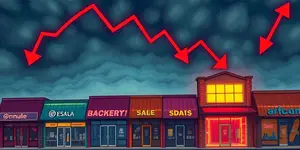
As global markets navigate economic headwinds and rapid technological shifts, mergers and acquisitions (M&A) have emerged as a powerful vehicle for companies seeking scale, innovation, and renewed growth. Despite an overall decline in deal volumes, the value and strategic significance of transactions are reaching new heights. In this context, organizations worldwide are leaning into consolidation to secure competitive advantage and spur transformation.
In the first half of 2025, deal volumes declined by 9% compared to the same period in 2024, marking a continuation of the downtrend since the record highs of 2021. Yet, the total value of deals presents a contrasting story. In consumer markets, values jumped by 13% even as volumes fell 16%, driven by a pronounced concentration of megadeals exceeding $5 billion. Financial services mirrored this pattern, posting a 15% rise in aggregate deal value while volumes edged down slightly.
Regional performance diverged sharply. The US saw a modest 6% uplift in deal volumes in Q1 2025, only to slow towards quarter-end amid tariff uncertainties and a cautious macro outlook. Projections for the full year remain in flux, ranging from flat to a potential 6% swing in either direction, dependent on interest rates, inflation trajectories, and GDP growth.
Across sectors and geographies, the M&A narrative is far from uniform. In consumer markets, companies are consolidating logistics and retail assets to optimize supply chains and capture scale economies. Landmark transactions—such as the $15.9 billion acquisition of Schenker by DSV—underscore a trend of cluster of large-scale consolidation aimed at fortifying market positions.
Financial services firms face transformative pressures from fintech innovations, regulatory shifts, and the pursuit of digital capabilities. Meanwhile, logistics players are balancing domestic consolidation with subdued international activity, hampered by geopolitical fragmentation and trade policy unpredictability. In Asia and Europe, local regulatory environments shape deal flow differently than in the US, prompting distinct strategic responses from regional players.
Several interrelated factors are propelling unrelenting interest in M&A as a strategic lever. With organic growth harder to achieve in saturated markets and rising input costs, CEOs are actively pursuing acquisitions to reshape business models, enter new markets, and access breakthrough technologies. Surveys show that while only 38% of CEOs are “very confident” in achieving near-term revenue growth, a majority (53%) foresee robust expansion three years out—underscoring a long-term rationale for deals.
Another powerful driver is the acceleration of digital transformation. Companies across industries are acquiring AI, cloud, and data analytics capabilities to secure an AI-driven competitive advantage. This trend is complemented by private equity exit pressure, as PE funds near the end of their portfolio holding periods and pursue liquidity through high-value divestitures and secondary buyouts.
Despite strong momentum, dealmakers face a suite of risks that could stall or reshape transaction pipelines. New US tariffs and immigration policies may introduce cross-border friction, prompting firms to delay or restructure planned deals. Meanwhile, macroeconomic variables—interest rates, inflation, corporate earnings—remain volatile. In less favorable scenarios, full-year deal volumes in the US could contract by up to 6%.
Venture capital funding has also decelerated, especially in the fintech sector, slowing growth-driven M&A even as traditional banks pursue digital acquisitions. Geopolitical fragmentation is another headwind, with divergent regulatory standards in Europe, Asia, and North America complicating cross-border integration plans.
In this complex environment, successful dealmakers emphasize flexibility, creative structuring, and rigorous value creation frameworks. Companies are experimenting with earnouts, joint ventures, and carve-out strategies to distribute risk and align incentives. The use of technology platforms to integrate acquired assets more swiftly has become a hallmark of leading acquirers seeking rapid synergies.
Effective due diligence now extends beyond financial metrics to encompass cultural fit, ESG compliance, and digital readiness. Post-merger integration teams are focusing on talent retention, unified data architectures, and agile governance models to ensure that acquisitions deliver on their strategic promise.
While overall M&A volumes may have softened, the market’s pulse beats stronger than ever in value and ambition. Consolidation is accelerating across consumer, financial, and logistics sectors, driven by the imperative to adapt, transform, and lead in an era of heightened uncertainty. For organizations poised to navigate these waters, the rewards of strategic acquisitions—greater scale, enhanced capabilities, and sustained competitiveness—are well within reach.
As 2025 unfolds, dealmakers who harness creativity, leverage technology, and anticipate regulatory shifts will be best positioned to thrive. In this landscape of sectoral consolidation and megadeals, agility and vision remain the defining traits of enduring success.
References













